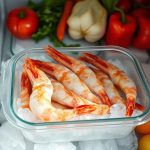Seafood boils are a delicious way to enjoy a variety of shellfish like shrimp, crab, lobster, clams, and mussels. The seafood is cooked together with vegetables like corn, potatoes, and sausage in a seasoned broth. The result is a flavorful, communal meal. However, having leftovers from a seafood boil can be tricky. The seafood can easily dry out or get rubbery when reheated. Follow this guide to learn the best methods for reheating seafood boil to keep it moist and flavorful.
Reheating Seafood Boil in the Microwave
The microwave provides a quick and easy way to reheat seafood boil.
- Place the seafood boil in a microwave-safe container. Use a bowl with a lid or cover the bowl with plastic wrap. This will help steam the seafood and prevent it from drying out. Glass containers work better than plastic.
- Microwave the seafood boil in 30 second intervals until heated through. Depending on the amount, this usually takes 2-4 minutes. Smaller portions will reheat faster.
- Stir halfway through and again at the end to ensure even heating. This redistributes the cold and hot spots.
- Add a couple tablespoons of water or broth to the seafood boil before microwaving to help add moisture. The liquid will create steam to rehydrate the seafood.
- Allow the seafood boil to rest for 2-3 minutes after microwaving before serving. This lets the heat distribute evenly throughout the dish.
- Check the temperature with a food thermometer to ensure seafood reaches 165°F.
Reheating Seafood Boil on the Stove
Many seafood boils are sold in boil-in-bag kits for easy cooking. Here is how to reheat them on the stovetop:
- Place the unopened bag of seafood boil in a large pot and cover completely with water. The bag will act as a steamer bag.
- Bring the water to a gentle simmer over medium heat. Don’t let the water boil rapidly.
- Simmer the bag for 10-15 minutes until the seafood is heated through. Occasionally move the bag around for even heating.
- Check the internal temperature of the seafood with a thermometer through the bag. It should reach 165°F.
- Remove the bag from the water carefully using tongs. Drain excess water from the bag before opening.
- Cut open the top of the bag to prevent hot steam from burning you.
Reheating Seafood Boil in the Oven
The oven allows you to reheat large batches of seafood boil evenly.
- Preheat oven to 375°F. Use a lower temperature for gentle reheating.
- Place seafood boil in a casserole dish or rimmed baking sheet in an even layer.
- Cover tightly with foil to lock in moisture and prevent drying out.
- Bake for 15-20 minutes until heated through. Stir halfway for even reheating.
- Check temperature with a thermometer to ensure seafood reaches 165°F.
- Allow to rest 5 minutes before uncovering to prevent steam burns.
- Drain excess liquid released while baking before serving.
Reheating Seafood Boil in the Slow Cooker
- Place the leftover seafood boil into the slow cooker stoneware. You can remove the shells from shrimp, crab legs, etc. if desired for easier eating.
- Add 1⁄4 to 1⁄2 cup of liquid such as broth, wine, or water. This will help add moisture as the seafood reheats.
- Cook on the LOW setting for 1-3 hours, until heated through. The time will depend on the amount you are reheating.
- Stir the seafood boil occasionally as it reheats to redistribute the heat.
- Break up any large pieces of seafood with a spoon to help them heat faster.
- For best results, do not overfill the slow cooker. Reheat smaller batches rather than cramming in too much seafood boil.
- Let the seafood boil rest for 5-10 minutes with the lid off after cooking to continue absorbing the moisture before serving.
- Garnish with fresh parsley or lemon wedges. Dip reheated seafood like shrimp or crab in melted butter.
- Transfer any uneaten portions to shallow containers, let cool completely, and refrigerate promptly. Do not reheat the seafood boil more than once.
Tips for the Best Results
- Don’t overcook the seafood or it can become rubbery. Reheat just until heated through.
- Add a tablespoon of butter or oil when reheating in the oven or microwave to prevent drying out.
- Stir in a little reserved seafood boil broth for extra moisture and flavor.
- Serve immediately once reheated for ideal texture and taste.
- Only reheat seafood boil once for food safety. Don’t keep reheating leftovers.
FAQs
How long does reheated seafood last?
Only reheat leftovers once. Reheated seafood boil should be eaten within 2-3 days for best quality and safety.
Should you add liquid when reheating?
Yes, adding a little broth or water creates steam to rehydrate the seafood.
What temperature should reheated seafood reach?
Seafood should reach an internal temperature of 165°F when reheated.
Can you reheat seafood boil in the slow cooker?
Yes, place seafood boil in a slow cooker with a little broth. Cook on low, stirring occasionally, until heated through.
Recipes
Cajun Shrimp Boil Dip
Combine reheated seafood boil with cream cheese and Cajun seasoning. Bake until bubbly. Serve with crusty bread.
Seafood Boil Chowder
Simmer reheated seafood boil in broth with potatoes, corn, and heavy cream. Finish with parsley.
Seafood Boil Frittata
Stir reheated seafood boil into egg mixture. Bake into an omelette-like frittata until set. Top with cheese.
Seafood Boil Salad
Toss reheated seafood boil with mixed greens, diced mango, and citrus vinaigrette dressing.
Here are some specific product recommendations for reheating seafood boil:
Microwave:
- Panasonic NN-SN966S – This is a high powered 1200W microwave with a stainless steel interior that makes it easier to clean after reheating seafood. It has a keep warm feature to hold food at the proper temperature.
- Toshiba EM131A5C-BS – A 1000W microwave with a large 1.3 cubic feet capacity and preset sensor cook menus for reheating different foods. It has a convection mode for more even cooking.
Oven:
- LG LDE4415ST – This electric range has an air fry mode that uses circulation to evenly reheat foods. The EasyClean® surface resists messes from boiling seafood.
- GE JB860SJSS – A gas range with a low temperature “simmer burn” that is good for gently reheating seafood without overcooking. It has a self-cleaning convection oven.
Stove:
- All-Clad Tri-Ply Stainless Steel Pots and Pans – Tri-ply construction has an aluminum core for even heat distribution when reheating seafood on the stovetop. Stainless steel resists corrosion from seafood boils.
- Tramontina Primaware Nonstick Pots and Pans – The PFOA-free nonstick coating prevents seafood from sticking when reheating on the stovetop. Dishwasher safe for easy cleanup.
Slow Cooker:
- Hamilton Beach Set & Forget 6-Quart – Automatically shifts to warm setting after cooking to hold seafood boils for serving. The locking lid resists spills.
- Crock-Pot 8 Quart Manual Slow Cooker – Large capacity for big batches of seafood boil. The ceramic vessel won’t react with acidic seafood ingredients.
With the proper reheating method, leftover seafood boil can taste nearly as amazing as the original meal. Follow these tips whenever you have a craving for seafood boil.




